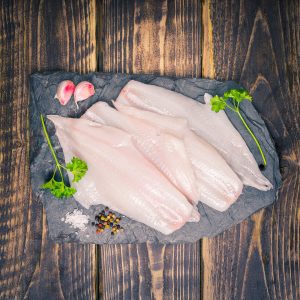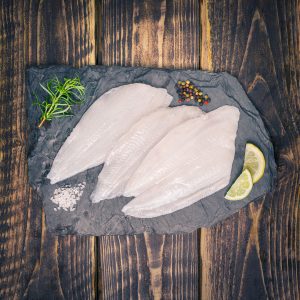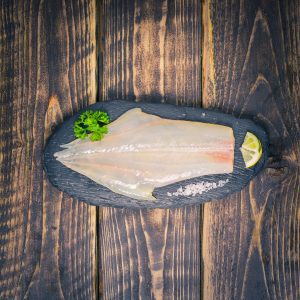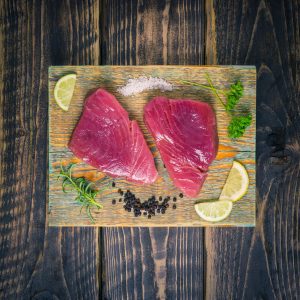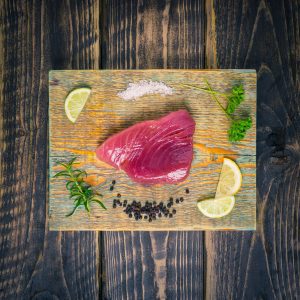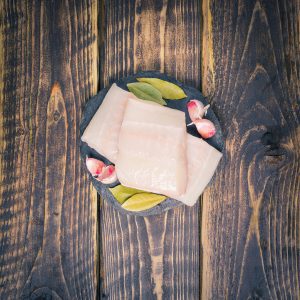It may be the top choice of chefs, but sea bass is also a great option for home cooks with a taste for luxury seafood. While in years gone by it came with a hefty price tag, now that populations have increased thanks to sustainable farming in the Mediterranean it is much more affordable. Simply pan fried with a knob of butter or combined with the complex depth of flavours in Asian dishes, sea bass is a firm favourite.
WHAT IS SEA BASS?
The fish we buy in the UK is European sea bass, or Dicentratus labrax. A member of the Moronidae family, which in turn is part of the wider Serranidae family, sea bass prefer the shallower regions of warm and tropical seas.
A coastal fish often found in estuaries, the sea bass is quite a character, carnivorous and perennially hungry, with a wide-ranging diet that includes everything from the smallest crustaceans and molluscs to bite-size members of its own species.
In The River Cottage Fish Book (A&C Black, 2007), authors Hugh Fearnley-Whittingstall and Nick Fisher actually describe wild sea bass as a predator of the ocean and refer to it as a “bit of a thug”. That explains why the French call sea bass the wolf of the sea.
“In fast currents and stormy seas, the bass’s hunter eyesight and streamlined profile give it the advantage over every other fish. It’s well tooled up for this rough and tumble lifestyle. Razor-sharp gill covers reinforced with thick cartilage armour, along with stiletto-pointed spines fanned through all of its fins, serve for both attack and defence.”
CLICK HERE TO BUY WHOLE SEA BASS
CLICK HERE TO BUY SEA BASS FILLETS
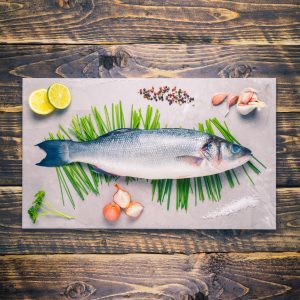
Adult females move closer inshore to warmer waters to spawn from March to mid-June. Spawning is in batches and eggs are pelagic. Eggs hatch and larvae drift inshore after three to four days and juvenile sea bass remain in shallow inshore waters for up to five years.
The fish migrate between inshore spawning grounds and feeding grounds further offshore. Surprisingly slow-growing for such hungry fish, it takes seven years before sea bass reach maturity, though they can live up to 25 years.
A perch-like fish, sea bass has an attractive silvery skin and hard scales which will need to be removed before cooking. The fish also has spines and those razor-sharp gill covers that Fearnley-Whittingstall refers to. The tail is generally straight-edged or rounded.
The firm, creamy-white, slightly oily flesh of sea bass is like a cross between cod and mackerel.
In Fish and Shellfish (BBC Books, 2014), Rick Stein describes sea bass as the most sought-after perch species for cooking. “A very attractive fish, it has beautiful silvery skin. It has a dense, slightly soft-textured flesh and a very delicate, superior flavour.”
The sea bass is quite a character, carnivorous and perennially hungry, with a wide-ranging diet that includes everything from the smallest crustaceans and molluscs to bite-size members of its own species
At one time caught off the coasts of Norway and the Baltic states to the Black Sea, and off the west coast of Africa, overfishing saw numbers drop dramatically and these days sea bass are commercially farmed in the eastern Mediterranean. This means sea bass is in plentiful supply all year round and much more affordable.
It’s important to know that targeted fishing for sea bass using nets is now effectively banned and the Marine Conservation Society (MCS) rates wild sea bass as a fish to avoid. The advice of the MCS is to buy certified sea bass.
In the wild sea bass can grow up to a hefty 7kg, while farmed fish are generally smaller, weighing in around 500g-800g.
WHAT’S AVAILABLE?
You can buy sea bass fillets or whole sea bass.
Sea bass fillets are cut from the spine to the tail.
Whole sea bass is, as the name suggests, a plate-sized individual fish. Our fish come gutted, cleaned and descaled.
IS SEA BASS GOOD FOR YOU?
It certainly is. Sea bass is full of protein, low in calories and an excellent source of omega-3 fatty acids.
Per 100g raw sea bass
Energy 168kcal
Fat 9.8g (of which saturated fat 2.16g)
Protein 20g
Rich in vitamin B12, niacin, phosphorus, potassium, selenium and thiamin
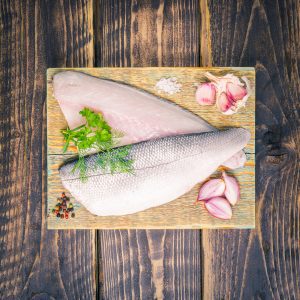
HOW DO YOU COOK SEA BASS?
The good news is you don’t have to be a trained chef to cook sea bass. A truly versatile saltwater fish that can be used in recipes as wide ranging as delicate sushi and kicking, spicy dishes, it’s easy to learn how to cook sea bass either pan fried, baked, baked whole in foil, barbecued or grilled.
Chefs are drawn to the sweet, textured flesh and gleaming, silvery skin of sea bass. Meatier than many other fish, the bold texture and flavour mean the fish isn’t overpowered by strong flavours, making it the perfect ingredient for Thai and Chinese cooking. The best way to cook it is speedily at a high temperature.
Top tip – chefs leave the skin on as it is not only a great source of nutrients but it has a lovely colour and texture.
Learning how to cook whole sea bass couldn’t be simpler. Stuff a whole fish with herbs for baking or grilling or bake in salt, wrapped in tinfoil, to make sure the flesh doesn’t dry out. Complement the flavours with oil, butter or herbs.
With so much flavour bursting out of the sea bass, keep it simple when thinking about what to serve with the fish
Sea bass fillets, which are firm but melt in the mouth, are well suited to grilling or pan-frying. Fillet recipes always advise to have the fish pin-boned before gently cooking.
Turn to Larousse Gastronomique (Hamlyn, 2009) to learn how to cook fillets in a recipe for sea bass with celeriac. “Season four sea bass fillets, each about 200g, with salt and cook them on a plancha [griddle], skin side down. Turn them off after six minutes and cook for a further two to three minutes. Do not cook the fish for too long: it should remain moist.”
The fish is coated with a red wine sauce and garnished with hot celeriac puree and fried celeriac slices.
Rick Stein pairs whole sea bass with the flavours of fennel and anise in a recipe from Fish and Shellfish. Stuffed with fennel, the fish is grilled on a high heat or on a barbecue, with one teaspoon of Pernod sprinkled on after six to eight minutes, before turning and grilling for another six to eight minutes. Sprinkle with more Pernod and serve with fennel mayonnaise.
SEA BASS RECIPES
Pair sea bass with strong, punchy flavours or sharp, sweet and sour Asian tastes for a simple supper or a knockout dinner party winner.
How to cook whole sea bass needn’t be daunting. Roast it whole with lemon and thyme or try something more adventurous such as baked in a salt crust with a citrus sauce.
The firm, creamy-white, slightly oily flesh of sea bass is like a cross between cod and mackerel
Cooking fillets under a grill, brushed with oil, makes the most of the natural sweetness and supple flesh. Baked fillets, with a caper dressing or a lemon and avocado oil, are an elegant option for no-fuss entertaining. While pan-fried recipes with fillets served in a lemon and garlic herb sauce or just lightly brushed with butter bring out all the delicious flavours of the crispy skin.
A sauce for sea bass can include any combination of lemon, parsley, garlic or butter with herbs to taste.
With so much flavour bursting out of the sea bass, keep it simple when thinking about what to serve with the fish. Grilled or steamed vegetables with boiled new potatoes nicely balance the lightness of sea bass.
How long to cook sea bass? As a rule of thumb, the fish should be baked in foil in the oven for about 20 minutes, or alternatively roasted uncovered for about 12 minutes, shallow fried for about 10 minutes, poached for up to seven minutes or grilled for three or four minutes each side.
Popular sea bass recipes, for fillets and whole fish, include:
- Whole sea bass baked in foil
- Grilled whole sea bass with fennel
- Baked sea bass with fennel
- Roast sea bass with chilli and lime
- Steamed sea bass with pak choi
- Pan-fried sea bass fillets
CLICK HERE TO BUY WHOLE SEA BASS
CLICK HERE TO BUY SEA BASS FILLETS



